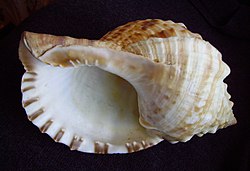Charonia lampas capax: Difference between revisions
GrahamBould (talk | contribs) First edition |
(No difference)
|
Revision as of 11:19, 6 January 2007
| Charonia lampas capax | |
|---|---|

| |
| From 90 feet off Kapiti Island, New Zealand. | |
| Scientific classification | |
| Kingdom: | |
| Phylum: | |
| Class: | |
| Order: | |
| Family: | |
| Genus: | |
| Species: | C. lampas capax
|
| Trinomial name | |
| Charonia lampas capax Finlay, 1927
| |
Charonia lampas capax is a marine mollusc in the family Ranellidae, endemic to New Zealand at depths of from low tide to 145 m. It is far more common in the north. Maximum height is 24 cm, and width 13 cm.
Charonia lampas capax has a large and solid shell, sculptured with two spiral series of prominent nodules, one peripheral, and many narrower cords of varying strength: weak to obsolete over the nodules. The outer lip is thickened and strongly indented. The inner lip has a strong parietel folding and a series of lesser foldings towards the anterior end.

Colour varies from white in deep-water shells, to strongly maculated in dark reddish-brown in shallow water shells. The aperture is white within, the labial varix with radial bars of brown. The periostracum is yellowish-brown. The operculum is large, thick, dark brown, elliptical, and with a terminal nucleus.
The empty shell was used by Maori as a trumpet, known as a putatara, until the arrival of Europeans.
References
- Powell A W B, New Zealand Mollusca, William Collins Publishers Ltd, Auckland, New Zealand 1979 ISBN 0-00-216906-1
